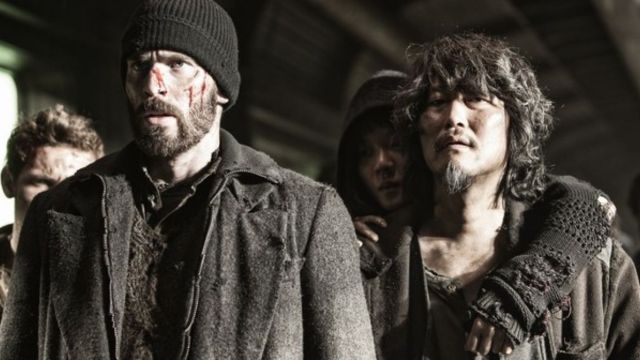How is Snowpiercer a Sequel to Willy Wonka? The Theory Explained
Some fans consider Snowpiercer (2013) to be a sequel to Willy Wonka and the Chocolate Factory (1971). Snowpiercer is a post-apocalyptic thriller depicting humanity’s struggle for survival in a frigid environment aboard trains.
The residents are stratified by class, with the less affluent confined to the rear of the train and the affluent enjoying a lavish existence at the front.
Willy Wonka is a narrative centered on a guy who conducts a tour of his confectionery factory for children, while covertly seeking a successor among them. They appear markedly dissimilar.
Despite Willy Wonka’s vibrant and entertaining nature, and Snowpiercer’s bleak and brutal themes, both narratives address economic class structures. Charlie Bucket hails from a lower socioeconomic background and observes golden tickets discovered by affluent and wealthy children.
Likewise, Curtis Everett originates from the rear of the train, characterized by darkness, congestion, and the consumption of energy bars derived from cockroaches.
Furthermore, both pertain to food and prominently include children. Intriguingly, Snowpiercer can be perceived as a sequel to Willy Wonka, featuring Ed Harris as the adult Charlie Bucket, now referred to as Wilford.
The Structural Parallels Between Snowpiercer and Willy Wonka
Snowpiercer and Willy Wonka and the Chocolate Factory are both intriguing narratives that explore social division. The majority of the youngsters visiting Willy Wonka’s factory are born into affluence and social influence, which Charlie lacks, granting him a distinct perspective and offering insight for the spectator.
Although Snowpiercer does not immediately disclose the privileged inhabitants of the train, the concept is analogous. The less affluent offer the audience their perspective on the narrative. The two films have similarities in narrative structure once the perspective is established.
The entire journey was a meticulously devised test by an affluent industrialist.
Initially, both Willy Wonka and Snowpiercer depict groups of individuals journeying through an extraordinary setting. Individually, in each room, an individual is lost, compelling the group to proceed without them until only a single person remains.
The individual then discovers that the entire expedition was an intricate test devised by an affluent entrepreneur in search of a successor.
In Willy Wonka, Charlie Bucket ultimately prevails to acquire a chocolate factory and its accompanying wealth. In Snowpiercer, Curtis Everett reaches the conclusion where Wilford presents him with the position of caretaker of the train’s engine.
Although Willy Wonka never received an official film sequel, there is a hypothesis suggesting that Snowpiercer may serve as one.
The Theory Suggests That Wilford Acquired His Methods From Willy Wonka
Various hypotheses exist on Willy Wonka; however, the Snowpiercer theory primarily focuses on Charlie. The premise is as follows: Willy Wonka has constructed a wholly insulated factory, rendering it entirely self-sufficient from the external environment.
Furthermore, he specializes in the production of unconventional meals and innovative transportation methods. He imparts his skills to Charlie Bucket, who is destined to uphold Wonka’s heritage.
This compels Charlie to forsake his previous name and adopt that of Wilford Wonka in tribute to his master.
Years later, during the events of Snowpiercer, he constructs a self-sustaining train, anticipating the catastrophic consequences of the CW-7 gas responsible for the perpetual winter depicted in the film.
To ensure the train remains self-sustaining, he must resort to drastic measures to regulate the population, including executing specific percentages when numbers become excessive or instigating revolts to perpetuate, as Wilford states, “anxiety and fear, chaos and horror to sustain life.”
Considering this, Charlie Bucket, now referred to as Wilford Wonka, has employed strategies and expertise acquired from his mentor, as demonstrated in the tunnel scene of Willy Wonka, to construct a realm of opulence and creativity aboard a train, mirroring Wonka’s previous endeavors within his factory.
He also adopts Wonka’s technique for identifying a successor by concealing messages in food—specifically, in the eggs intended for Curtis, analogous to Wonka’s golden tickets embedded in chocolate bars.
However, if this idea holds true, where are the Oompa Loompas from Willy Wonka and the Chocolate Factory, the diminutive individuals tasked with operating and maintaining his machinery?
Wilford notes that the source sustaining his train’s engine has “recently gone extinct,” compelling him to utilize tiny children, as seen in Snowpiercer. This elucidates the absence of the Oompa Loompas while thematically emphasizing the conclusions of both films: children will inherit the future.
Look at the interesting theory connecting Snowpiercer and Willy Wonka through hidden parallels in social stratification, survival, and succession. Is Snowpiercer really a sequel to the magical heritage of Willy Wonka?
See the connections that have captivated fans. For others fascinating insights and theories, please visit our website today!




Comments are closed.